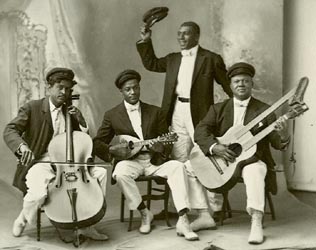First blues families: the Thomas’s.
George W. Thomas Jnr, Hersal and Hociel Thomas, Sippie Wallace (nee Thomas) and Bernice Edwards.
Last time, we talked about the family of Henderson Chatmon, the ‘musicianer’, as musicians called themselves in the nineteenth century, from Bolton, Mississippi. Henderson, a former slave, and his wife Eliza, ran a family string band around the turn of the 20th century.
Three of their musical sons, Amenter (aka Bo Carter), Lonnie and Sam Chatmon, of course, became famous in the 1930s both as solo artists and together in the Mississippi Sheiks.

But were there other families who performed strains of music leading up the blues even earlier than the Chatmons? We know Henderson Chatmon was born a slave around 1850, so he would have been fifteen when proclaimed free after the U.S. Civil War.
In 1883, five years before the oldest Henderson child was born, the eldest of another talented family that helped pioneer the blues was born in Little Rock, Arkansas.
His name was George Washington Thomas Jnr., first born of an obviously patriotic black couple, George W. Snr. and Fanny Thomas, who moved from Arkansas to Texas in the 1890s.
This is one of George Jnr.’s composition below, sung by his sister, Sippie Wallace. Sippie, born Beulah Thomas, won new audiences in the 1970s when Bonnie Raitt recorded some of her songs.
George and Sippie’s father, George W. Thomas Snr., was a deacon at the Shiloh Church in Houston, one of America’s earliest black Baptist churches. With his wife, Fanny, they produced thirteen musically-talented children, two more even than Henderson and Eliza Chatmon had, with their eleven kids up in Boston, Mississippi.
Famous boogie woogie piano pioneers.
And while the Chatmon clan performed in their parents’ string band, the Thomas children cut their musical teeth in their father’s Houston church. George Jnr., brother Hersal, sister Beuleh, their niece, Hociel, and, later, their adopted sister Bernice, all sang in the Shiloh church choir and learned to play the church piano and organ.
George and Hersal Thomas went on to have stellar keyboard careers, pioneering boogie woogie piano, while Sippie became the famous vaudeville blues singer, ‘The Texas Nightingale (1898–1986). Niece, Hociel Thomas (1904 – 1952), also starred in vaudeville as a boogie woogie pianist, blues and jazz singer. Adopted sister, Bernice, brought up by the Thomas family in Houston, is remembered as the blues singer and pianist, Bernice Moanin’ Edwards. She was born around 1910.
In 1914, George Thomas Jnr. moved to New Orleans to join the legendary early blues and jazz pioneer, Clarence Williams (1893 – 1965). Clarence claimed (probably accurately) to be the first songwriter ever to use the word jazz on a piece of sheet music, with a business card touting him as ‘The Originator of Jazz and Boogie Woogie’. Jelly Roll Morton was another making such a declaration, but Williams has the more authentic claim. This is examined more in my book, America’s Gift.
Gut Bucket George (1883 – 1965).
But George Thomas, too, could play a mean boogie woogie piano, being known on the circuit as Gut Bucket George. That’s him above. In 1916, George W. Thomas Jnr. published ‘The New Orleans Hop Scop Blues’, often considered the first 12-bar boogie woogie published. This really helped established him as a music publisher and composer. By now, sister, Sippie, and brother, Hersal, had followed George to New Orleans. Here’s Bessie Smith’s version of New Orleans Hop Scop Blues, below:
While George was successfully publishing, composing and performing in New Orleans’ infamous Storyville red light district, Sippie was singing blues with the likes of King Oliver and Louis Armstrong. Young Hersal (1906 – 1926) was famous in New Orleans as a child prodigy, taught, of course, by George.

When the New Orleans authorities shut down the Storyville district in 1917 (for being too sexually notorious), George moved north to Chicago. That same year, Sippie Thomas married Matt Wallace, a pianist, composer and bandleader, and, together, they played the TOBA circuit of Southern theatres.
In the early 1920s, Hersal and Sippie joined George Thomas Jnr. in Chicago, where all three became big stars of the city’s burgeoning blues and jazz scene.
As well as ‘The New Orleans Hop Scop Blues’, George Washington Thomas Jnr. composed a further 100 songs, including the popular ‘Houston Blues’ and the 1922 smash, ‘Muscle Shoals Blues’. George also wrote with sister Sippie, whose recordings of their songs, ‘Shorty George Blues’ and ‘Underworld Blues’, became big hits.

Boogie woogie classics.
In 1922, George W. and Hersal Thomas wrote and published their classic boogie woogie composition, ‘The Fives,’ inspired by the sounds of railroad travel. This instrumental became so synonymous with 1920s boogie-woogie piano in Chicago, pianists needed to play it when auditioning for work. The Fives is also cited as a big influence on the famous 1930s school of Chicago boogie woogie pianists, Albert Ammons, Meade Lux Lewis and their Kansas contemporary, Pete Johnson.
The piano prodigy, Hersal Thomas, died suddenly of food poisoning in 1926 at the young age of 20. George W. Thomas died after falling down the stairs in 1937.
Four years earlier, in 1923, George wrote and recorded ‘The Rocks’, featuring the earliest recording of a walking bass line, under the pseudonym, Clay Custer. However, some boogie woogie scholars credit young brother, Hersal, as the performer.
Here’s George (or Hersal) Thomas recording below as Clay Custer in 1923. Perhaps it’s both of them playing. We’ll never know. The mysteries of the blues continue.





